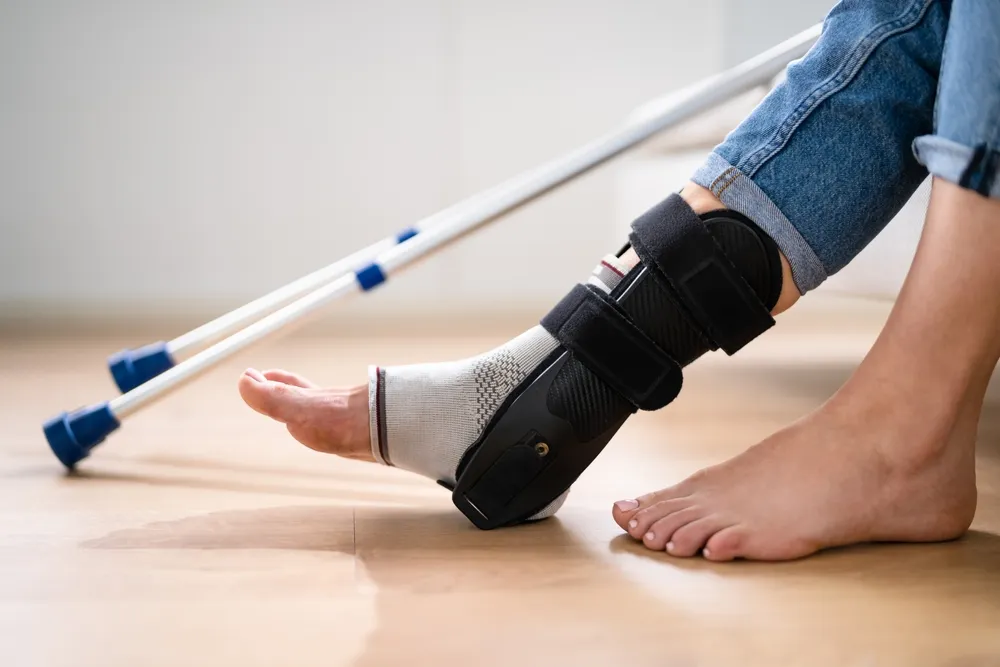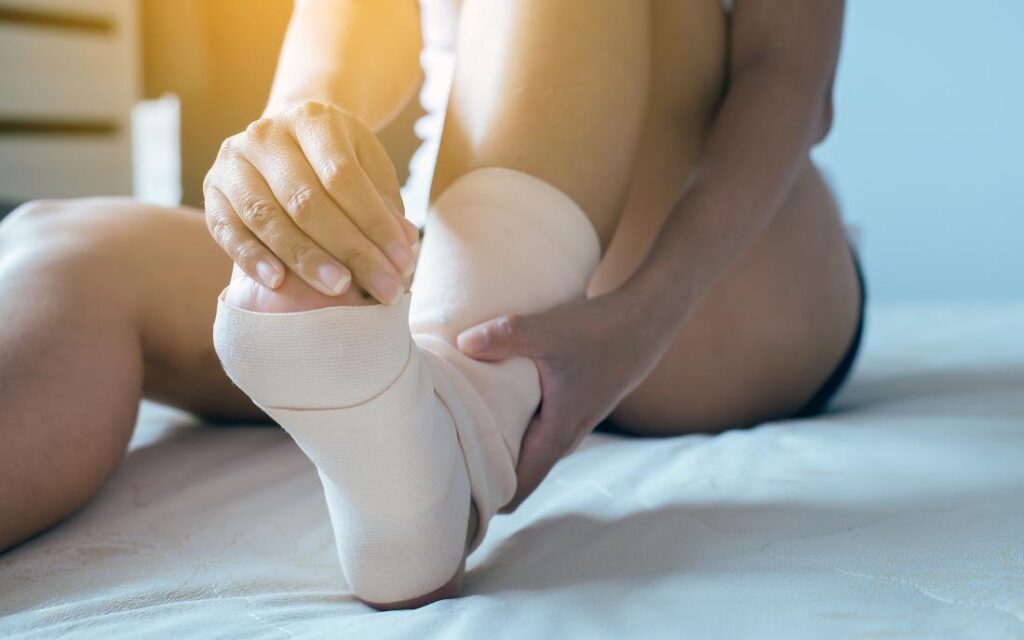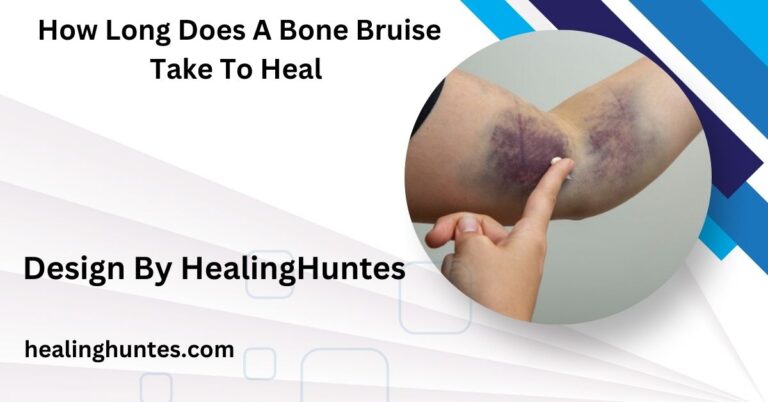How Long Does A Sprained Foot Take To Heal – Sprained Foot Recovery Timeline!
Healing time for a sprained foot varies from 1-12 weeks based on severity, with RICE and proper care speeding recovery. Mild sprains heal in 1-2 weeks, moderate in 3-6 weeks, and severe cases may take up to 12 weeks or more.
This article provides a detailed look at the recovery timeline, factors affecting healing, and ways to help speed up the process.
How Long Does a Sprained Foot Take to Heal? A Comprehensive Guide:

Spraining a foot is more common than many might think, as it can happen during everyday activities or athletic pursuits. A foot sprain occurs when the ligaments—strong, flexible bands of tissue that connect the bones—are stretched beyond their capacity, leading to discomfort, swelling, and even bruising.
Understanding Foot Sprain Severity Levels:
The healing time of a sprained foot varies based on the severity of the sprain. Let’s dive deeper into each grade of sprain:
Grade 1: (Mild Sprain)
- Description: A Grade 1 sprain involves minor stretching of the ligaments. While there may be mild pain and minimal swelling, the ligaments remain largely intact.
- Symptoms: Mild tenderness, slight swelling, and minor discomfort when walking.
- Healing Time: Roughly 1-2 weeks with proper care.
- Care Tips: Immediate RICE (Rest, Ice, Compression, Elevation) is usually effective. A mild sprain typically doesn’t need medical intervention and can be managed at home.
Grade 2: (Moderate Sprain)
- Description: A Grade 2 sprain results in a partial ligament tear. Symptoms are more noticeable and may include moderate pain, swelling, and even bruising.
- Symptoms: Pain during weight-bearing activities, noticeable swelling, bruising, and some instability.
- Healing Time: Around 3-6 weeks, depending on rest and rehabilitation.
- Care Tips: RICE, along with physical therapy exercises to regain mobility, can speed recovery. Some people benefit from using a brace or wrap to stabilize the foot.
Also Read: How To Heal Receding Gums – Natural Gum Healing!
Grade 3: (Severe Sprain)
- Description: In a Grade 3 sprain, the ligament is completely torn, which leads to more severe pain and instability.
- Symptoms: Severe pain, significant swelling, extensive bruising, and an inability to bear weight.
- Healing Time: 8-12 weeks or more, often requiring medical intervention.
- Care Tips: A severe sprain may need immobilization through a cast or brace, physical therapy, and in rare cases, surgery.
Factors That Influence Healing Time:

Various factors can influence how long it takes to heal from a sprained foot:
- Age: Younger people may heal faster because of better blood circulation and tissue regeneration.
- Overall Health: People in good physical health, especially with a balanced diet, are likely to recover faster.
- Lifestyle: Active individuals or those who place continuous strain on their feet may experience slower healing.
- Adherence to Treatment: Consistent care, including physical therapy and RICE, can help speed recovery.
The RICE Method: A Core Approach to Foot Sprain Recovery:
- Rice: is a proven, effective way to reduce pain and inflammation in a sprained foot. Here’s how to do it right:
- Rest: Avoid any activities that might strain the foot. Use crutches if necessary to stay off the injured foot.
- Ice: Apply an ice pack to the sprained area for 15-20 minutes every 2-3 hours in the first 48 hours. This reduces swelling and numbs pain.
- Compression: Wrap the foot with an elastic bandage. Make sure it’s snug but not so tight that it cuts off circulation.
- Elevation: Keep the foot elevated above the heart to minimize swelling. Propping it up on pillows while resting or sleeping helps.
Also Read: How To Heal Receding Gums – Natural Gum Healing!
Advanced Recovery Techniques:
After the initial RICE phase, additional recovery methods can help strengthen the foot and restore mobility:
- Physical Therapy: Physical therapy exercises are vital for moderate to severe sprains. A physical therapist can guide you through movements that improve strength, flexibility, and balance.
- Strength and Flexibility Exercises: Once the initial pain subsides, strengthening exercises can restore stability. Simple exercises include toe raises, foot rotations, and using resistance bands.
- Massage Therapy: Gently massaging the foot improves blood flow and reduces stiffness in the ligaments and surrounding muscles.
- Using Braces and Supportive Footwear: For moderate to severe sprains, a brace or supportive footwear can stabilize the foot, helping prevent further injury during recovery.
How to Tell If Your Sprain Is Healing?

Signs of progress include:
- Reduced Swelling and Bruising: Swelling should gradually decrease over time.
- Decreased Pain: Pain should subside, allowing for increased mobility and ability to put weight on the foot.
- Improved Range of Motion: You should be able to move the foot more freely without intense discomfort.
- Increased Strength: As you perform strengthening exercises, the foot should feel more stable and stronger.
Long-Term Care and Prevention:
To avoid future foot sprains and promote long-term foot health, consider these preventive measures:
- Wear Proper Footwear: Supportive shoes with a good arch can reduce the risk of future sprains.
- Strengthen Your Ankles and Feet: Exercises like calf raises, ankle rotations, and toe scrunches help build foot and ankle strength.
- Warm-Up Before Physical Activity: Stretching the muscles and warming up ligaments prepares your body for movement, reducing the risk of injury.
- Mind Your Environment: Avoid walking on uneven or slippery surfaces, and be mindful of where you step.
Recognizing When to Seek Professional Support
- Persistent Pain: If pain continues despite rest and home care, it may indicate a more serious injury.
- Swelling That Doesn’t Subside: Persistent swelling can suggest additional complications that require medical attention.
- Instability in the Foot: Ongoing instability could signal damage to ligaments or other structures in the foot.
- Advanced Treatments: A healthcare provider can recommend treatments like physical therapy or support devices for severe sprains.
- Imaging Tests: In some cases, X-rays or MRIs can reveal hidden injuries, such as ligament tears or fractures.
- Full and Confident Recovery: Professional support ensures a safe and effective healing process, helping you return to activities with stability and confidence.
FAQ’s
1. How long does it take for a mild sprain to heal?
A mild foot sprain typically heals within 1-2 weeks with rest and RICE treatment.
2. What is the RICE method for sprained foot recovery?
RICE (Rest, Ice, Compression, Elevation) helps reduce swelling and pain, aiding in faster recovery.
3. How long does a severe sprain take to heal?
Severe sprains can take 8-12 weeks or longer, often requiring medical treatment or physical therapy.
4. What are signs that my sprain is healing?
Reduced swelling, decreased pain, improved mobility, and increased strength are signs of healing.
5. When should I seek medical attention for a sprained foot?
If you have persistent pain, swelling, or instability after a few weeks, it’s best to consult a doctor.
Conclusion
In conclusion, healing from a sprained foot depends on the severity of the injury. Following the RICE method and adhering to proper care can speed up recovery. Mild sprains may heal in 1-2 weeks, while severe cases may take 8-12 weeks. If symptoms persist, consult a healthcare professional for further evaluation and treatment.






